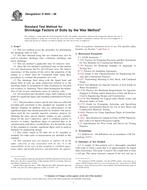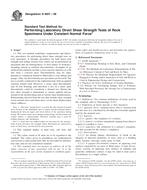We need your consent to use the individual data so that you can see information about your interests, among other things. Click "OK" to give your consent.
ASTM D4943-08
Standard Test Method for Shrinkage Factors of Soils by the Wax Method (Withdrawn 2017)
Automatically translated name:
Standard Test Method for Shrinkage Factors of Soils by the Wax MethodSTANDARD published on 1.6.2008
The information about the standard:
Designation standards: ASTM D4943-08
Note: WITHDRAWN
Publication date standards: 1.6.2008
SKU: NS-29230
The number of pages: 6
Approximate weight : 18 g (0.04 lbs)
Country: American technical standard
Category: Technical standards ASTM
The category - similar standards:
Annotation of standard text ASTM D4943-08 :
Keywords:
Atterberg limits, linear shrinkage, shrinkage, shrinkage limit, Calibration--soil/rock analysis instrumentation, Cohesive soils, Cracking, Earthwork, Linear shrinkage, Shrinkage--soil, Soil-moisture analysis, Swell potential, Water analysis, Wax method, ICS Number Code 13.080.20 (Physical properties of soil)
Additional information
| Significance and Use | ||||||||||||||||||||||||
|
The term shrinkage limit, expressed as a moisture content in percent to the nearest whole number, represents the amount of water required just to fill all of the voids of a given cohesive soil at its minimum void ratio obtained by ovendrying. The shrinkage limit can be used to evaluate the shrinkage potential, crack development potential, and swell potential of earthwork involving cohesive soils. Note 1—The quality of the result produced by this standard is dependent on the competence of the personnel performing it, and the suitability of the equipment and facilities used. Agencies that meet the criteria of Practice D 3740 are generally considered capable of competent and objective testing/sampling/inspection/and the like. Users of this standard are cautioned that compliance with Practice D 3740 does not in itself assure reliable results. Reliable results depend on many factors; Practice D 3740 provides a means of evaluating some of those factors. |
||||||||||||||||||||||||
| 1. Scope | ||||||||||||||||||||||||
|
1.1 This test method covers the procedure for determining the shrinkage limit of soils. 1.2 The data obtained using this test method may also be used to calculate shrinkage ratio, volumetric shrinkage, and linear shrinkage. 1.3 This test method is applicable only for cohesive soils. 1.4 Since this test method is performed only on that portion of a soil which passes the No. 40 (425-μm) sieve, the relative consistency of this portion of the soil to the properties of the sample as a whole must be considered when using these procedures to evaluate the properties of a soil. 1.5 The shrinkage limit along with the liquid limit and plastic limit of soils are often collectively referred to as the Atterberg limits in recognition of their formation by Swedish soil scientist, A. Atterberg. These limits distinguish the boundaries of the several consistency states of cohesive soils. 1.6 All recorded and calculated values shall conform to the guide for significant digits and rounding established in Practice D 6026. 1.6.1 The procedures used to specify how data are collected/recorded and calculated in this standard are regarded as the industry standard. In addition, they are representative of the significant digits that should generally be retained. The procedures used do not consider material variation, purpose for obtaining the data, special purpose studies, or any considerations for the user’s objectives; and it is common practice to increase or reduce significant digits of reported data to be commensurate with these considerations. It is beyond the scope of this standard to consider significant digits used in analysis methods for engineering design. 1.7 The values stated in SI units are to be regarded as standard. No other units of measurement are included in this standard. 1.8 This standard does not purport to address all of the safety concerns, if any, associated with its use. It is the responsibility of the user of this standard to establish appropriate safety and health practices and determine the applicability of regulatory limitations prior to use. For specific safety hazards, see Section 7 and Note 4 and Note X1.1. |
||||||||||||||||||||||||
| 2. Referenced Documents | ||||||||||||||||||||||||
|
Similar standards:
Historical
1.7.2008
Historical
1.6.2014
Historical
1.7.2008
Historical
1.1.2012
Historical
15.1.2014
Historical
1.7.2007
We recommend:
Technical standards updating
Do you want to make sure you use only the valid technical standards?
We can offer you a solution which will provide you a monthly overview concerning the updating of standards which you use.
Would you like to know more? Look at this page.



 ASTM D3877-08
ASTM D3877-08 ASTM D5334-14
ASTM D5334-14 ASTM D5607-08
ASTM D5607-08 ASTM D5778-12
ASTM D5778-12 ASTM D5779/D5779M-14..
ASTM D5779/D5779M-14.. ASTM D5852-00(2007)..
ASTM D5852-00(2007)..
 Cookies
Cookies
